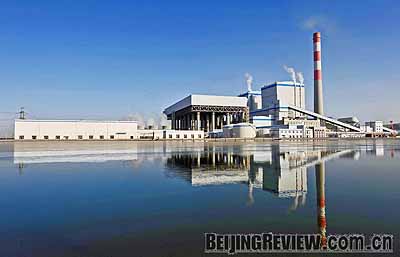| As the Wall Street financial chaos has demonstrated, some deep-rooted economic ailments defy quick fixes. For China, solving some of its structural problems that have taken the shine off its decade-long economic boom also poses long-term challenges.
 |
|
ENERGY SAFETY: China started building a large coal power base in the eastern part of Ningxia Hui Autonomous Region in December 2008, as part of its efforts to ensure stable power supplies (WANG PENG) | But the government, facing dark growth prospects, now seems quite determined and patient with those challenges. It has been pushing forward industrial upgrading and innovation and also putting in place a long-stalled revamp of the oil pricing and taxation system. Now it has turned to the coal-fueled power sector that accounts for four fifths of the country's total power generation.
The country's National Energy Work Conference in early February in Beijing sent a clear message that the country would seek to redress the long-standing supply-and-demand imbalances for coal and electricity through the construction of large coal power bases.
"Construction of those bases across the country will speed up this year," said Zhang Guobao, Director of the National Bureau of Energy under the National Development and Reform Commission (NDRC), at the conference. "This represents a future trend for the power sector that has been gripped by coal shortages."
China's thermal coal tightness peaked last summer when demand for power exploded during the then hot economy. But the coal-fueled generators were reluctant to rack up painful losses by paying coal prices that had soared far faster than state-set electricity tariffs. Transportation bottlenecks also inflamed coal supply tensions and jacked up prices that the generators were not allowed to pass on to consumers.
But since the financial crisis started, the situation has taken a U-turn. While the industries that consume most of the country's electricity have taken a heavy blow, the power crisis has significantly eased with coal prices dropping and some generators even idling their units. According to the NDRC, China's total power consumption in 2008 grew a mere 5.23 percent year on year, 9.57 percentage points lower than a year earlier.
Although the urgent coal shortages have largely abated, industry analysts believe building large coal power bases is necessary to guard against a future power crisis. Coal shortages and electricity outages could reoccur when power consumption picks up as the industrial climate gradually warms up, they said.
"Moreover, the current downturn has offered an opportunity for the country to consolidate its coal power industry, which is highly fragmented and inefficient," Zhang said.
Last year, China jumped into second place in terms of global installed power generation capacity after years of spectacular growth. But with the boom came an array of thorny problems, such as an over-reliance on coal-fueled power, overloaded transportation networks and environment pollution.
"It's time to shut some small coalmines and reorganize coal resources," Zhang said.
He added, "The softening of power shortages creates some breathing space for the strategic shake-ups. Besides this, falling commodity prices, the easing monetary environment and tax cuts are also an anticipated boon for the financing and construction of the big projects."
Solid bases
For years, the government has been scratching its head over how to break the entrenched barriers between coal and electricity industries and hasten their integration. It has encouraged thermal power generators to buy into or take over coal plants or develop their own coalmines. On top of these solutions came the national campaign to build large-scale coal power bases that integrate both electricity generation and coal mining. In 2004, China started a long-awaited program to build 13 large coal bases across the country, among which those with mature conditions would be developed into giant coal power bases.
"The biggest advantage of such bases is that they can obtain uninterrupted coal supplies however strained the market is," said Wang Wei, a power analyst at Guotai Jun'an Securities Co. Ltd., in a report. "Also, they would be freed from transportation bottlenecks that choked the coal sources for many power plants."
Meanwhile, the power giants, each of which logs an annual coal output of at least 100 million tons, will gain an upper hand in government support and market share, thus squeezing out their smaller rivals, said Wang Shuai, a coal analyst at Orient Securities Co. Ltd., in an interview with Shanghai Securities Journal.
| 